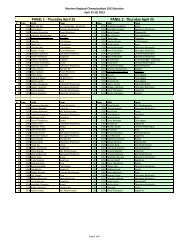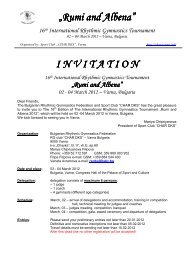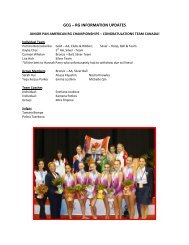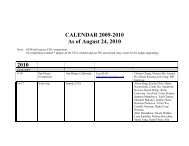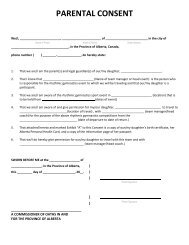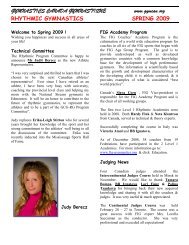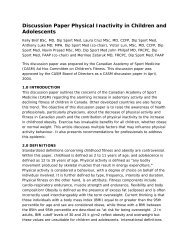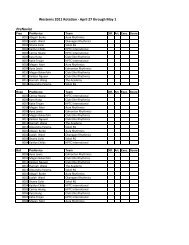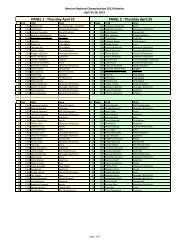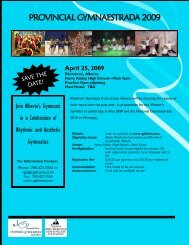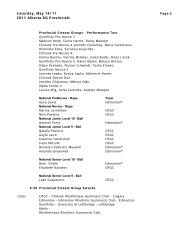Warming Up Cooling Down and Stretching - Rhythmic Gymnastics ...
Warming Up Cooling Down and Stretching - Rhythmic Gymnastics ...
Warming Up Cooling Down and Stretching - Rhythmic Gymnastics ...
Create successful ePaper yourself
Turn your PDF publications into a flip-book with our unique Google optimized e-Paper software.
<strong>Warming</strong> <strong>Up</strong> <strong>Cooling</strong> <strong>Down</strong> <strong>and</strong> <strong>Stretching</strong><br />
Preparing for a workout <strong>and</strong> recovering afterward deserve a lot more attention than<br />
many believe.<br />
By Mort Malkin, M.D.<br />
Warm-ups in fitness <strong>and</strong> sports are performed in accordance with each person’s<br />
own idea of the purpose of warming up. <strong>Cooling</strong> down is generally given little<br />
attention. <strong>Stretching</strong> varies widely from person to person, each going through a<br />
“routine.”<br />
Yet, there are fundamental principles based on human anatomy <strong>and</strong> physiology to<br />
use for guidance in warming up, cooling down <strong>and</strong> stretching. The purposes of<br />
these three workout supplements are different, <strong>and</strong> should be examined one by<br />
one.<br />
<strong>Warming</strong> up<br />
<strong>Warming</strong> up should prepare the muscles that will be used in the workout. These<br />
muscles must be physically warm for good reason. When a muscle contracts, not all<br />
the individual fibers contract at once; some are kept in reserve. So, there is tension<br />
created among the contracting fibers <strong>and</strong> non-contracting fibers, <strong>and</strong> in the<br />
connective tissues between fibers. Warm tissues are more supple <strong>and</strong> less likely to<br />
suffer mini (or even maxi) tears.<br />
<strong>Warming</strong> up muscle tissues <strong>and</strong> the associated connective tissues can be<br />
accomplished by internal or external means. Exercisers can raise total body<br />
temperature with a hot tub. They can use physical therapy interventions such as<br />
diathermy, ultra-sound or a whirlpool. They can have a massage therapist use<br />
rhythmic pressures to reach targeted muscle groups. <strong>Warming</strong> up must be<br />
performed close to workout time, <strong>and</strong> the apparatus <strong>and</strong> personnel should be onsite<br />
for theses external warm-up modes. (Many people have the misperception that the<br />
best way to increase blood flow to an area is by using hot packs. Actually, the<br />
application of external heat increases the blood flow to the skin, not deeper<br />
structures such as muscles <strong>and</strong> organs.)<br />
Internal means of warming the muscles are far more convenient <strong>and</strong>, arguably,<br />
more effective. Internal warming is achieved by bringing warm blood to the<br />
muscles. The control of blood perfusion to muscles responds best to muscle<br />
contraction, <strong>and</strong> to the build up of metabolites from the biochemical energy cycles.<br />
The simplest way to warm up specific muscles is to make those muscles work at a<br />
light to moderate intensity for a few minutes.
Warm-up exercises are muscle-group-specific. It would be of little or no benefit to a<br />
runner to perform a series of h<strong>and</strong> <strong>and</strong> wrist exercises before a race. That may be<br />
an extreme example, but the principle holds true: Warm up with the same exercise<br />
that will be used in the workout, but at a slower pace. Three or four minutes should<br />
suffice.<br />
How about stretching as a warm-up <strong>Stretching</strong> has a purpose - after the workout<br />
<strong>and</strong> after the cool-down. Studies have shown that stretching before exercise does<br />
not prevent either soreness or injury. Indeed, stretching cold muscles can cause<br />
muscle fiber tears. There is no objection to first warming up, <strong>and</strong> then performing<br />
specific stretches for those muscles that will be employed in the workout.<br />
Better yet, exercisers can perform a range-of-motion routine for the limbs <strong>and</strong><br />
torso. Be careful they don't force the range to the point of pain or significant<br />
discomfort.<br />
Preventing injury is largely a matter of proper biomechanics, effective training for<br />
the workout <strong>and</strong> not pushing past training thresholds<br />
<strong>Cooling</strong> down<br />
<strong>Cooling</strong> down (or warming down) is important after a workout. There are two<br />
reasons for a warm down. The first is more important, <strong>and</strong> concerns systemic<br />
circulation. When an exerciser has been moving at a strong pace for a time, heart<br />
rate <strong>and</strong> blood volume are elevated. Cardiac output during exercise is driven by 1)<br />
a high volume of blood return; 2) greater dilation of the chambers of the heart; <strong>and</strong><br />
3) stronger contraction of the myocardial muscle particularly of tale left ventricle.<br />
The pulsation of the arteries completes the systolic blood pressure phase of the<br />
cardiac cycle throughout the arterial side of the circulatory system. The return of<br />
blood to the heart through the venous side of the system has no such primary<br />
pump. Return blood flow depends on venous pressure at 10 to 15 mmHg, a minimal<br />
force compared to arterial pressure of 8 to 120 mmHg.<br />
During exercise, particularly lower-body exercise, the rhythmically contracting<br />
muscles act as pumps to speed up the venous blood flow hack to the heart. In<br />
weight-bearing exercises such as running, exercise walking <strong>and</strong> cross country<br />
skiing, gravity is a significant force that must be overcome so that the heart<br />
receives enough blood to send to the lungs for re-oxygenation <strong>and</strong> on to all the<br />
vital organs <strong>and</strong> other tissues. If a runner stops moving after a race, the heart<br />
would continue beating rapidly for at least another minute or two. Blood in the<br />
lower body, however, would not have any help from the exercising muscles in its
eturn to the heart. Only the normal venous pressure, a minimal force, would be<br />
available to combat the force of gravity. There would be less blood for the heart to<br />
pump to the brain, kidneys, lungs <strong>and</strong> on to the coronary arteries that supply the<br />
heart muscle itself. <strong>Warming</strong> down by continuing the exercise of the workout at a<br />
slower pace will continue to move venous blood upward from the lower body until<br />
the heart slows <strong>and</strong> a rest state is stabilized.<br />
The second reason for the warm-down is to help remove the metabolites - lactic<br />
acid <strong>and</strong> other organic acids - that can build up. If the workout was a competition,<br />
race pace will build up a higher level of metabolites than a training workout. Most<br />
competitors, whatever the sport, perform at a slightly higher intensity <strong>and</strong> release<br />
more adrenaline. Both factors cause more oxygen use, a greater exhaustion of<br />
muscle glycogen <strong>and</strong> some usage of straight chain amino acids as an energy<br />
substrate. During competition, the athlete dips into anaerobic reserve a little,<br />
especially at the end of the competition. A continued, easy rhythmic contraction of<br />
the muscles after the workout will maintain circulation to "wash out" the<br />
metabolites.<br />
<strong>Stretching</strong><br />
After a workout, muscles are tired <strong>and</strong>, even with a warm-down, will have an<br />
elevated level of metabolites. In this condition, muscles can easily go into spasm. It<br />
commonly happens in running, race walking <strong>and</strong> even fast exercise walking.<br />
<strong>Stretching</strong> should occur after the warm-down <strong>and</strong> again later in the day to jog the<br />
memory of the muscles. How to stretch is more complex. There are many muscles<br />
in the body, <strong>and</strong> several in each of the muscle groups are the weight-bearing,<br />
power-producing muscles used in each particular sport or exercise. There is,<br />
however, a general principle to follow: Whatever motion of limb or torso results<br />
from the contraction of a particular muscle or muscle group, the opposite motion<br />
will lengthen that muscle.<br />
An example relevant to running is the quadriceps group of muscles When the quads<br />
contract, they normally straighten the leg. In running, the knees are slightly bent.<br />
Thus, the quads must support the weight of the body. To underst<strong>and</strong> the<br />
biomechanics of running in terms of quadricep power, have clients visualize the<br />
changing degree of the bend, from the beginning of the stride to the end. At the<br />
"support phase" of the stride, the knee starts at a sight bend. As that foot moves<br />
back under the body's center of gravity, the leg must bear increasing weight <strong>and</strong> so<br />
the knee bends more. At that point, the quads are trying to contract to support the<br />
body's full weight, but at the same time they are being, lengthened by the<br />
increased leg bend. This type of muscle contraction is called "eccentric." Many
successive, strong eccentric contractions, as in downhill running cover a distance of<br />
one mile or more, may result in Focal muscle cell damage <strong>and</strong> extreme soreness.<br />
From the middle of the support phase until the end of the stride at toe-off, the knee<br />
straightens under normal concentric contraction of the quads.<br />
To stretch the quads, the muscle group must be held in a lengthened position for<br />
about 30 seconds. To lengthen the in muscle group, runners should place their<br />
limbs or torsos in a position opposite to that of muscle contraction. As contraction<br />
of the quads normally straightens the leg bending the leg will lengthen the muscle<br />
group. To accomplish this, exercisers can st<strong>and</strong> on one leg <strong>and</strong> bend the other one<br />
by lifting the foot up behind them <strong>and</strong> holding it in place by grasping the foot or<br />
ankle (Figure 1). Runners are often seen performing this quad stretch. The stretch<br />
can also be performed by lying face dawn on the ground, bending one leg back <strong>and</strong><br />
holding it in the bent position, again by grasping the ankle or foot.<br />
Hamstring; stretches need a limb position opposite to the quad stretch. Hamstring<br />
contraction during exercise normally would bend the leg back <strong>and</strong> up during<br />
exercise. But if the exercise or sport is weight-bearing, the hams will exert a<br />
backward force on the entire leg. In this, they act in concert with the gluteal<br />
extensors. The effect is to move the whole body forward. <strong>Stretching</strong> (lengthening)<br />
the hams require bending the body at the waist with a fairly straight leg. A sitting<br />
or st<strong>and</strong>ing position can be used.<br />
The calf muscles (gastrocnemius <strong>and</strong> soleus) also need stretching. When the calf<br />
muscles contract, they move the forefoot (toes <strong>and</strong> metatarsals) down. So,<br />
stretching the calves requires moving the forefoot up, or toward the knee. Clients<br />
call sit on the ground with their h<strong>and</strong>s pulling the forefoot hack toward the knee but<br />
it is probably easier to do a "wall stretch" (Figure 2). Facing the wall, have clients
place one foot near the wall <strong>and</strong> extend the other two-<strong>and</strong>-a-half to three lengths<br />
back. Keeping the back heel on the ground, have them bend their front knee <strong>and</strong><br />
move their hips forward. In effect, the toes of the front foot will be moved in the<br />
direction of tile knee, <strong>and</strong> the angulation oft he foot to lower leg will form less than<br />
a right angle.<br />
Running requires at least quad <strong>and</strong> calf stretches. Race walking <strong>and</strong> aerobic<br />
exercise walking require hamstring <strong>and</strong> calf stretches. Cross country skiing requires<br />
all three stretches.<br />
The principles for all post-exercise stretches hold true regardless of the exercise.<br />
First, muscles normally shorten when they contract, <strong>and</strong> to stretch a muscle it must<br />
he lengthened. Second, whatever direction the body moves when the muscle<br />
contracts, exercisers must move the body in the opposite direction to stretch it.<br />
These principles can be applied to any exercise <strong>and</strong> any muscle groups. Figure out<br />
which muscles are contracting when clients run, jump, turn or move different parts<br />
of the body repetitively in a workout. Then have them move to the opposite<br />
position for the muscle groups that they wish to stretch.<br />
Be kind to muscles<br />
Aerobic exercise requires sustained, rhythmic contractions of large muscle groups,<br />
preferably in a weight-bearing manner. The factor of distance (or time) is generally<br />
about 40 to 50 minutes. That requires perhaps 3,000 strong contractions - a<br />
significant amount of work. These muscle groups deserve a modicum of kindness.<br />
Proper warm-tip, warm-down <strong>and</strong> stretching are the least exercisers can do for
their muscles; if exercisers are kind to their muscles, their muscles will be kind to<br />
them.<br />
Mort Malkin, M.D. is an attending surgeon emeritus at the Brooklyn Hospital Center,<br />
<strong>and</strong> the author of Aerobic Walking: The Weight Loss Exercise.<br />
__________________________________________________________________<br />
____________<br />
Title<br />
<strong>Warming</strong> <strong>Up</strong> <strong>Cooling</strong> <strong>Down</strong> <strong>and</strong> <strong>Stretching</strong><br />
Preparing for a workout <strong>and</strong> recovering<br />
afterward deserve a lot more attention than<br />
many believe.<br />
Author Molkin, M.<br />
Source<br />
Publisher<br />
Fitness management (Los Angeles)<br />
Leisure Publications<br />
Vol/Issue 20(2)<br />
Date Jan 2004<br />
SIRC Article # S-940749




